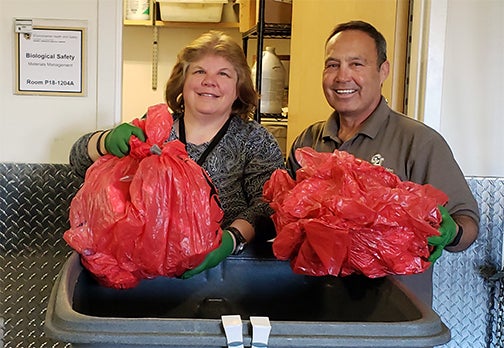The OUC and FSS Help will be closed Monday, January 19, 2026, in honor of Martin Luther King, Jr. Day. We will reopen for normal business hours on Tuesday, January 20.
Summary
Anschutz Medical Campus researchers and clinicians generate more than 82 tons of regulated biohazardous waste every year. A contracted vendor used to transport this waste offsite for autoclaving prior to disposal. The team established a new process using autoclaves available in campus research buildings. Their initiative saves money, promotes a safer workplace, and establishes a more environmentally sustainable program to manage regulated waste.
Submission Highlights
Team Information

Pictured Above:
- Denise A. Donnelly, Associate Biosafety Officer
- Mark Garcia, Biowaste Technician
- University of Colorado Denver | Anschutz Medical Campus
Description
The Anschutz Medical Campus (AMC) researchers and clinicians generate more than 82 tons/yr of regulated biohazardous waste. The Biosafety Division in the Department of Environmental Health and Safety (EHS) manages the biowaste program for AMC and provides daily biowaste pick-up service to all research and clinical buildings. A contracted vendor is used transport this waste to their facility that is more than an hour away. This waste is autoclaved and then disposed of in a public landfill. The waste is no longer hazardous or regulated once it has been autoclaved, so it is now safe to be in the landfill.
An autoclave program has been established at AMC to autoclave waste using the autoclaves that are already available in research buildings. The biowaste program staff autoclaves bags of biohazardous waste daily, thereby diverting it from the vendor for a cost savings.
The program staff focuses on one research building, however, researchers have now been requesting to participate in this this program to autoclave their own waste. These combined efforts can potentially double the cost saving over the next 6 - 12 months with significant future growth potential. The university spends more than $80,000/yr with a vendor to autoclave this waste.
How does this benefit the University?
This program will benefit AMC and have the ability to expand to the Denver campus as well. The university will realize a financial savings, promote a safer workplace, and establish a more environmentally sustainable program to manage this regulated waste stream through the following practices:
Financial Savings:
- Reduce the number of bags of regulated biohazardous waste that would be autoclaved by the vendor
- Researchers autoclaving their own waste will reduce biosafety staff time to pick-up the number of bags of waste
Safer Workplace:
- Reduce the amount of biohazardous waste that would be handled by Biosafety staff and contract vendor
- Reduce the movement of biohazardous waste within a building
Environmental Sustainability:
- Reduce the carbon footprint of transporting biohazardous waste from AMC to the vendor’s facility
- Reduce the volume of biohazardous waste to landfill by using a high-vacuum autoclave process for up to a 70% volume reduction
Implementation/Future Plans
A pilot autoclave program was initiated at AMC in June of 2017 and immediately showed success in the number of bags of regulated biohazardous waste that were safely autoclaved and diverted from the contracted vendor. A total of 4 tons (866 bags) of regulated waste had been autoclaved by EHS Biosafety staff for a savings of almost $6,000 in the first 6 months. Given the success of this pilot program, a permanent autoclave program is now established in a research building that is the second largest generator of biohazardous waste on the Anschutz Medical campus.
Expansion of this program is currently underway to have researchers’ autoclave their own biohazardous waste that will further our efficiency efforts and cost savings for this program.




